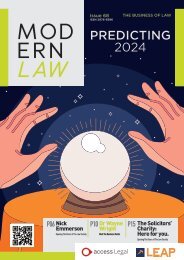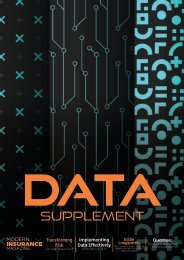Modern Insurance Magazine Issue 65
Create successful ePaper yourself
Turn your PDF publications into a flip-book with our unique Google optimized e-Paper software.
INSURTECH<br />
Innovation to Outpace Cyber Threat<br />
in our Interconnected Landscape<br />
In a data-dependent, heavily-regulated sector,<br />
failure to take proactive, preventive steps<br />
against cybercrime is flirting with disaster. The<br />
importance of a robust and secure technology<br />
infrastructure that protects data across every<br />
link within your supply chain is more vital than<br />
ever.<br />
Tech innovation to enable the safeguarding of exposure to<br />
cybercrime is evolving at pace for insurance businesses.<br />
Smart firms are paying attention to this developing<br />
cybersecurity landscape and the products available, while<br />
adopting a systemic and cultural approach to proactively<br />
safeguard their organisational exposure to cybercrime.<br />
The statistics are frightening. Ramsac reports cybercrime<br />
costs hitting £27 billion annually, with figures projected<br />
to soar to £8 trillion by 2025. With 72.2% of organisations<br />
globally experiencing ransomware attacks in 2023, and only<br />
8% recovering all data post-payment, the stakes are high.<br />
Innovation holds hope<br />
There are plenty of new technologies, both current and<br />
on the horizon, to assist insurance businesses in their fight<br />
against cyber threat. Technologies focused on ensuring<br />
that innovation outpaces cyber threat and develops cyber<br />
resilience include:<br />
• Artificial Intelligence and Machine Learning, which<br />
leads the way in threat detection by analysing data for<br />
suspicious patterns.<br />
• Zero Trust Architecture, which demands strict identity<br />
checks, marking a significant advancement in combating<br />
threats.<br />
These developments highlight a proactive stance in digital<br />
asset security, critical in today’s interconnected landscape.<br />
Systemic and cultural resilience<br />
From a standards perspective, adherence to ISO 27001<br />
is a critical component of a cyber security strategy. This<br />
global standard can serve as a cornerstone, guiding the<br />
establishment of a comprehensive information security<br />
management system (ISMS). While embracing innovative<br />
technologies is crucial, pairing them with a structured<br />
framework like ISO 27001 ensures systematic management<br />
and protection of sensitive data against emerging threats. It’s<br />
more than mere compliance; it’s also about creating a resilient<br />
and proactive defence mechanism.<br />
But as with most things in business, the greatest threat is not<br />
so much the technology but the people themselves. Humans<br />
nearly always prove to be the most fallible link in the chain.<br />
Whether it’s regular training sessions, simulated phishing<br />
exercises or incentivised secure behaviour, there are lots of<br />
proven ways to reduce that risk.<br />
However, the most effective way remains a robust and<br />
uncompromising security program that encrypts hard drives,<br />
blocks outside connections and monitors everything. If it<br />
doesn’t feel like overkill, you’re probably not pushing hard<br />
enough.<br />
A unified approach<br />
As we navigate through an era where data is both currency<br />
and liability, it’s clear that the responsibility to safeguard<br />
such precious assets cannot be understated. The alarming<br />
statistics and the relentless surge of cyber threats serve<br />
as a clarion call for a unified, rigorous approach to cyber<br />
resilience. Now is the time to act.<br />
• Blockchain - its tamper-proof technology upholds data<br />
integrity and secure transactions.<br />
• Quantum Cryptography, which is set to overhaul data<br />
security and offer immunity to traditional hacks.<br />
• Edge Computing Security, which tackles the challenges<br />
at the network’s edge and remains vital for the Internet<br />
of Things (IoT).<br />
• Security Automation, Orchestration, and Extended<br />
Detection and Response (XDR), which enhances threat<br />
responses and ensures wide-ranging organisational<br />
protection.<br />
Ed Halsey,<br />
VP Marketing, Genasys<br />
MODERN INSURANCE | 85
















